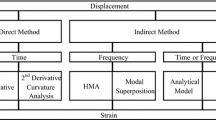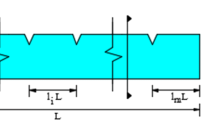Abstract
Structures and equipment subject to dynamic loading are prone to a shortened life span due to excessive vibration levels, which can lead to fatigue failure of its components. Continuous monitoring of those systems can be a complicated and expensive task, due to the complexity and difficulty of accessibility to some locations, which makes it difficult to assess the structural integrity. One way to deal with this subject is to use finite element model, operational modal analysis, and the modal expansion method to predict dynamic responses in locations that have not been measured. In this work, a calibrated modal model of a rectangular aluminum beam suspended in air, in free–free boundary condition, was used to predict acceleration responses. The experimental modal matrix was obtained through impact tests and the system equivalent reduction expansion process (SEREP) technique was used to reduce the beam’s Finite Element model, thus ensuring the compatibility between numerical and experimental degrees of freedom. Model calibration was carried out using the local correspondence principle. Finally, by using the modal expansion method, the calibrated modal model was used to predict dynamic responses. Results showed high accuracy between the measured and the predicted acceleration signals.



















Similar content being viewed by others
Abbreviations
- [K]:
-
Stiffness matrix
- [M]:
-
Mass matrix
- [T]:
-
Reduction transformation matrix
- \(\{\phi \}\) :
-
Experimentally obtained mode shapes (unscaled)
- \(\small \{q(t)\}\) :
-
Modal coordinates
- \(\tiny \small \{X(t)\},\{{\dot{X}}(t)\},\{{\ddot{X}}(t)\}\) :
-
Displacement, velocity and acceleration vectors
- \(\{z\}\) :
-
Numeric mode adjustment coefficient vector
- \(\small \{{\varPhi }\}\) :
-
Numerically obtained mode shapes
- a, d:
-
Active and deleted degrees of freedom
- i :
-
Iteration index
- p :
-
Number of modes considered in modal truncation
- [B]:
-
Numeric vibration modes cluster
- [\(K_{\text {r}}\)], [\(M_{\text {r}}\)]:
-
Reduced stiffness and mass matrices
- {F}:
-
Vector of loads acting on the system
- COMAC:
-
Coordinate modal assurance criteria
- EFDD:
-
Enhanced frequency-domain decomposition
- FE:
-
Finite element
- TRAC:
-
Time response assurance criteria
- LC:
-
Local correspondence principle
- MAC:
-
Modal assurance criteria
- MAE:
-
Mean absolute error
- RD:
-
Relative difference
- RMSE:
-
Root mean squared error
- SEREP:
-
System equivalent reduction expansion process
- FRAC:
-
Frequency-response assurance criteria
References
R.J. Allemang, The modal assurance criterion–twenty years of use and abuse. Sound Vib. 37(8), 14–23 (2003)
P. Avitabile, Model reduction and model expansion and their applications. Part 2—applications. In Conference Proceedings of the Society for Experimental Mechanics Series (2005). ISSN 21915644
P. Avitabile, E. Harvey, J. Ruddock, Comparison of full field strain distributions to predicted strain distributions from limited sets of measured data for SHM applications. Key Eng. Mater. 569–570, 1140–1147 (2013)
R. Brincker, et al., A local correspondence principle for mode shapes in structural dynamics. Mech. Syst. Signal Process. 45(1), 91–104 (2014). ISSN 08883270. Disponível em: https://doi.org/10.1016/j.ymssp.2013.10.025
L. Busson, et al., Output-only modal parameter identification of a rectangular beam using MIMO and SIMO tests. In Ibero-Latin American Congress on Computational Methods in Engineering, Natal, RN, Brazil, vol 1, p. 6096 (2019)
Y. Chen, D. Joffre, P. Avitabile, Underwater dynamic response at limited points expanded to full-field displacement response. J. Vib. Acoust. 140(October), 1–9 (2018). ISSN 15288927
C. Chipman, P. Avitabile, Expansion of transient operating data. Mech. Syst. Signal Process. 31, 1–12 (2012). ISSN 08883270. Disponível em: https://doi.org/10.1016/j.ymssp.2012.04.013
M.I. Friswell, J.E. Mottershead, Finite Element Model Updating in Structural Dynamics (Kluwer Academic Publishers, 1995). ISBN 0-7923-3431-0
A. Iliopoulos, et al., A modal decomposition and expansion approach for prediction of dynamic responses on a monopile offshore wind turbine using a limited number of vibration sensors. Mech. Syst. Signal Process. 68–69, 84–104 (2016). ISSN 10961216. Disponível em: https://doi.org/10.1016/j.ymssp.2015.07.016
A.N. Iliopoulos, et al., Continuous fatigue assessment of an offshore wind turbine using a limited number of vibration sensors. In EWSHM-7th European Workshop on Structural Health Monitoring, 8–11 July 2014, Nantes, France, pp. 772–779 (2014)
J. Kullaa, Virtual sensing of structural vibrations using dynamic substructuring. Mech. Syst. Signal Process. 79, 203–224 (2016). ISSN 10961216. Disponível em: https://doi.org/10.1016/j.ymssp.2016.02.045
F. Liu, Direct mode-shape expansion of a spatially incomplete measured mode by a hybrid-vector modification. J. Sound Vib. 330(18–19), 4633–4645 (2011). ISSN 0022460X. Disponível em: https://doi.org/10.1016/j.jsv.2011.05.003
K. Maes, G. De Roeck, G. Lombaert, Response estimation in structural dynamics. In Proceedings of the International Conference on Structural Dynamic, EURODYN, January–July 2014, pp. 2399–2406 (2014). ISSN 23119020
C.O. Mendonça, et al., Numerical and experimental correlation of a rectangular beam using a Guyan-SEREP mixed method. In XL CILAMCE Ibero-Latin American Congress on Computational Methods in Engineering, Natal, RN, Brazil (2019)
J. O’Callahan, P. Avitabile, R. Riemer, System equivalent reduction expansion process (SEREP). In Proceedings of the International Modal Analysis Conference—IMAC XVII, pp. 29–37 (1989)
P. Pingle, P. Avitabile, Full-field dynamic stress/strain from limited sets of measured data. Sound Vib. 45(8), 10–14 (2011). ISSN 15410161
Z.-Q. Qu, Model Order Reduction Techniques (Springer, London, 2004). ISBN 978-1-84996-924-6
A. Sestieri et al., Estimation of rotational degrees of freedom by EMA and FEM mode shapes. Conf. Proc. Soc. Exp. Mech. Ser. 6, 355–365 (2013)
M. Tarpø, et al., Expansion of experimental mode shape from operational modal analysis and virtual sensing for fatigue analysis using the modal expansion method. Int. J. Fatigue (2020). ISSN 01421123
Author information
Authors and Affiliations
Corresponding author
Rights and permissions
About this article
Cite this article
Mendonça, C.d.O., Gutiérrez, R.H. & Monteiro, U.A. Prediction of dynamic responses in a rectangular beam using the modal expansion method. Mar Syst Ocean Technol 16, 29–42 (2021). https://doi.org/10.1007/s40868-020-00091-3
Received:
Accepted:
Published:
Issue Date:
DOI: https://doi.org/10.1007/s40868-020-00091-3




